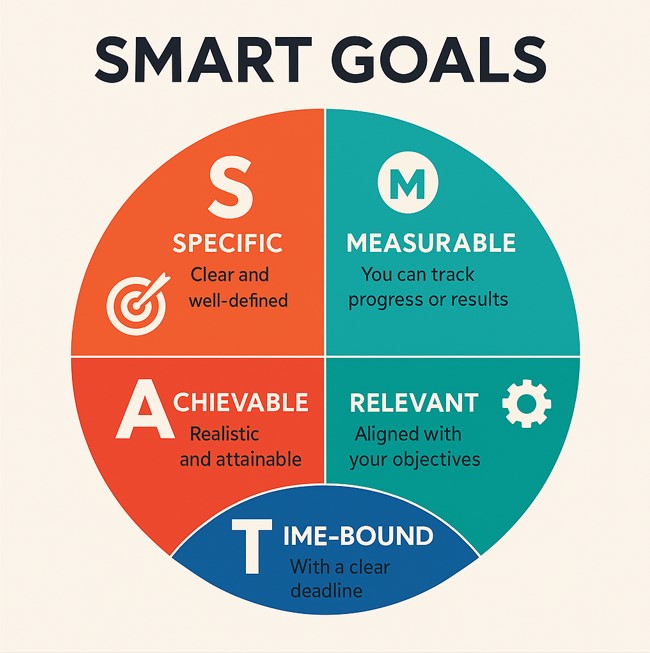Let’s be real—winging it rarely leads to the kind of success you’re dreaming about. If you’ve got big goals but no clear plan, it’s like driving blindfolded. You need direction, a proper roadmap to achievement, and a few solid tools in your back pocket.
This isn’t about overcomplicating things—it’s about gaining clarity, setting SMART goals, and staying laser-focused on what actually moves the needle. Whether you’re chasing personal growth, building better time management habits, or hitting business milestones, it all starts with the right mindset and a solid action plan.
In this post, I’ll walk you through everything from prioritization and execution, to the little habits that boost your productivity and get real results. It’s not magic—it’s just good planning, done right. Ready? Let’s map out your success roadmap and get you moving.
Laying the foundation for success
Before we dive into to-do lists and fancy templates, let’s take a step back. Planning for success isn’t about cramming more into your calendar or downloading another productivity app. It’s about clarity. Knowing where you’re heading, why it matters, and what’s going to keep you moving when motivation dips.
The power of a success plan
Think of your plan as a personal GPS. Without it? You’re just guessing. A solid success roadmap helps you stay focused, cut out the fluff, and move with purpose—not panic. It turns big, overwhelming dreams into smaller, doable steps. And it keeps you accountable when life inevitably throws curveballs.
Shaping a growth mindset
Here’s the truth: your plan is only as strong as your mindset. If you believe success is out of reach or only for “those people,” it’s game over before you start. But if you’re open to learning, adjusting, and failing forward? That’s when real progress happens. This isn’t about being perfect—it’s about showing up consistently, even when you’re not sure it’s working yet.
/image
Setting clear goals and identifying challenges
Now that your head’s in the game, let’s get into the real work. Saying “I want to be successful” is fine, but it doesn’t mean much until you define what that actually looks like. If you’re a business owner, it might mean increasing revenue, streamlining operations, or finally launching that product you’ve had in your head for months. Whatever it is, vague goals won’t get you there. You need clarity.
Establishing SMART objectives
This is where SMART goals come in—Specific, Measurable, Achievable, Relevant, and Time-bound. It’s not buzzword nonsense. It’s how you turn broad ambitions into actions that get results.

Let’s say you are a sole trader and run a service-based business. “I want more clients” becomes “I want to onboard 5 new clients in the next 60 days by increasing outreach and improving my website’s conversion rate.” Now you’ve got something you can work toward, track, and improve.
Here’s a quick breakdown:
| SMART Criteria | What It Means | Business Example |
|---|---|---|
| Specific | Clear and well-defined | “I want to hire a part-time assistant.” |
| Measurable | You can track progress or results | “I want to generate $20,000 in new revenue this quarter.” |
| Achievable | Realistic based on current resources | “With my current workload, I can handle 2 more clients per month.” |
| Relevant | Aligns with long-term business goals | “Hiring help allows me to focus on business development.” |
| Time-bound | Has a deadline | “I’ll make the hire by the end of the month.” |
Real success planning means knowing where you’re going, why it matters, and what it takes to get there. And yes, sometimes that means stripping goals down to the boring, practical stuff. But that’s where real progress starts.
Navigating common obstacles
Every business owner hits roadblocks. Maybe your calendar is chaos, your inbox is overflowing, had o fill theses GST returns every 2 months, or you’re constantly pulled into client fires that stop you from working on your own business. It’s easy to lose focus, even with the best intentions.
The solution? Expect these challenges, and plan for them. Here are a few that come up often:
- You’re wearing too many hats. You do sales, admin, client work—everything. Time to consider delegating or automating repetitive tasks.
- You’re stuck in the planning phase. You’ve got a vision, but you haven’t moved. Action beats perfection. Build, test, improve.
- You run out of steam halfway. This usually means the goal wasn’t realistic—or it wasn’t broken down into manageable steps. Reassess and adjust.
Remember: the obstacles aren’t the problem. It’s how you respond to them that determines if you keep moving or stay stuck. Success planning isn’t rigid—it flexes with you. But you’ve got to keep driving it forward.
Planning for success: Building your roadmap and taking action
Now we’re getting to the good stuff—execution. This is where most people stall. They’ve got the goals, maybe even a fancy notebook full of ideas… but no clear path to actually make it happen. That’s where a practical, simple roadmap comes in. Nothing flashy—just real steps that keep you moving.
Structuring your plan step-by-step
The best way to avoid overwhelm? Break it down. Take each big goal and split it into smaller tasks with clear deadlines. Don’t just say “improve marketing.” Say “rewrite my website homepage this week” or “schedule three LinkedIn posts every Monday morning.”
Let’s say your objective is to grow revenue by 20% this year. What does that look like in action?
- Review your current sales data
- Identify your top-performing offer
- Plan a campaign around that product or service
- Allocate time each week to lead generation
- Set monthly revenue targets and track them
When you look at it like that, it’s not a dream anymore. It’s a process. That’s the power of a roadmap—it makes progress measurable and less intimidating.
Want to go deeper? These books are gold when it comes to building better systems and turning vision into action:
- The 12 Week Year by Brian P. Moran – a practical guide to crushing goals faster by ditching the annual plan.
- Atomic Habits by James Clear – perfect if you want to shift your habits and actually stick to them.
- Deep Work by Cal Newport – a must-read if distractions are killing your productivity.
- Essentialism by Greg McKeown – learn how to focus only on what truly moves the needle in your business.

Accountability and resources
No one executes perfectly on their own. You need systems, people, or routines to keep you on track. For some business owners, that might mean using project management tools like Trello, Notion, or Asana. For others, it could mean blocking out “CEO time” each week—no client calls, just strategy and review.
If you’re part of a team, make sure responsibilities are crystal clear. Who owns what? What’s the timeline? What happens if something gets delayed?
Even solo? Build accountability into your week. That could mean:
- Weekly check-ins with a mentor or business coach
- Monthly reporting for yourself (yes, seriously)
- Joining a mastermind or peer group that pushes you forward
The point is: don’t rely on willpower alone. Set up support systems that make follow-through the default—not the exception.
Reflecting, adapting, and celebrating wins
You’ve done the hard part—set clear goals, built a roadmap, and taken action. But here’s the part that separates the people who talk about success from the ones who actually get there: reflection. If you don’t pause, review, and adjust, you’re just running on a treadmill—busy, but not really going anywhere.
Measuring progress and recalibrating
What’s working? What’s not? If you’re not asking yourself these questions regularly, you’re leaving results on the table. Schedule time—monthly, quarterly, whatever fits—to look at your numbers, review your goals, and make honest calls.
Let’s say you set a goal to bring in 5 new clients in 60 days. If you’re halfway there after 30, great—double down. If you’ve only signed one, it’s not a failure, it’s feedback. Maybe your offer needs tweaking. Maybe your outreach isn’t landing. Either way, now you know.
Treat your plan like a living thing. Adjust the timeline. Shift priorities. Pivot when the data tells you to. Planning for success doesn’t mean getting everything right on the first go—it means staying committed to progress, not perfection.

Staying motivated and rewarding progress
Here’s something most business owners forget to do: celebrate. You hit a revenue goal? Landed a tough client? Finished that project you kept putting off? Don’t just move on to the next thing—take a moment. Success isn’t just in the big wins; it’s in the consistency, the discipline, and the fact that you showed up when it would’ve been easier not to.
Small rewards work. A day off, a dinner out, a break from the grind. Whatever gives you energy—do more of that when you hit your milestones. It’s how you stay motivated long-term, especially when you’re juggling a thousand things and no one’s clapping for you but you.
Success is built on this rhythm: plan → execute → review → repeat. And if you keep showing up with that mindset? You’ll get where you want to go. It might take longer than expected, it might not look like what you pictured—but it’ll be yours.
Final thoughts: success doesn’t happen by accident
Planning for success isn’t about having everything figured out from day one. It’s about being intentional. Having a clear vision. Taking consistent action. And being willing to course-correct when things don’t go as planned.
The truth? Most people don’t plan. They drift. They stay busy but never really move forward. But you’re not here for that. You’re here to get results—to build something that lasts.
So here’s your next step: carve out one hour this week. Review your goals. Write them down. Break them into actions. Build your roadmap. Doesn’t have to be perfect—just has to be real. Then start moving.
And if you want more guides like this, drop your email or follow the blog—I’ve got more straight-talking content coming your way to help you plan smarter, stress less, and actually hit those goals.
You’ve got this. Now go make it happen.
